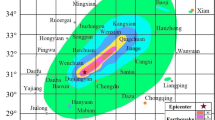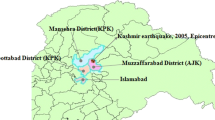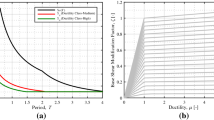Abstract
This study aims at the proposition of a probabilistic framework for the vulnerability assessment of reinforced concrete (RC) buildings subjected to seismically induced slope displacements due to landslide hazard. The proposed approach combines the seismic hazard analysis with the displacement hazard analysis and the fragility analysis of the structure. First, a probabilistic seismic hazard curve for the selected intensity measure(s) is derived together with the associated information for magnitude and magnitude/distance disaggregation based on a traditional probabilistic seismic hazard analysis (PSHA). Then, a displacement hazard curve is obtained based on the associated seismic hazard analysis results and appropriate scalar or vector models to predict the seismically induced slope displacements. Finally, a damage hazard curve of a typical RC frame structure subjected to the seismically induced landslide hazard is computed describing the annual rate of exceeding different damage limit states. Various sources of uncertainty are taken into account including the aleatory variability on the seismic and displacement hazard, the structural demand and the definition of damage limit states as well as the structure’s capacity. To incorporate epistemic uncertainties in the proposed framework, a logic tree analysis is proposed to derive a weighted mean and different fractiles damage hazard curves. The proposed approach is illustrated on a hypothetical low-rise RC frame structure impacted by the earthquake induced landslide hazard. The importance of the yield coefficients and displacement predictive models to the slope’s performance, structural response and vulnerability is highlighted.



















Similar content being viewed by others
References
Akkar S, Sandıkkaya MA, Bommer JJ (2014) Empirical ground-motion models for point- and extended-source crustal earthquake scenarios in Europe and the middle east. Bull Earthq Eng 12:359–387
Argyroudis S, Pitilakis K (2012) Seismic fragility curves of shallow tunnels in alluvial deposits. Soil Dyn Earthq Eng 35:1–12
Ausilio E, Zimmaro P (2015) Displacement-based seismic design of a shallow strip footing positioned near the edge of a rock slope. Int J Rock Mech Min Sci 76:68–77
Baker JW (2007) Correlation of ground motion intensity parameters used for predicting structural and geotechnical response. In: 10th international conference on applications of statistics and probability in civil engineering, Tokyo
Baker JW (2008) An introduction to probabilistic seismic hazard analysis (PSHA). Version 1:3
Baker JW, Cornell CA (2006) Correlation of response spectral values of multicomponent ground motions. Bull Seismol Soc Am 96(1):215–227
Bazzurro P (1998) Probabilistic seismic demand analysis. Ph.D. Dissertation. Department of Civil and Environmental Engineering, Stanford University, California, p 329
Bazzurro P, Cornell CA (1999) Disaggregation of seismic hazard. Bull Seismol Soc Am 89(2):501–520
Bazzurro P, Cornell CA (2002) Vector-valued probabilistic seismic hazard analysis. In: Proceedings 7th US national conference on earthquake engineering, Boston, MA, p 10
Bazzurro P, Manfrediniand GM, Diaz Molina I (1995) Applications of seismic damage hazard analysis for the qualification of existing nuclear and offshore facilities. SMiRT-13, POST CONFERENCE, SEMINAR No. 16 on Seismic Evaluation of Existing Nuclear Facilities
Bird JF, Bommer JJ (2004) Earthquake losses due to ground failure. Eng Geol 75:147–179
Bird JF, Crowley H, Pinho R, Bommer JJ (2005) Assessment of building response to liquefaction induced differential ground deformation. Bul of the New Zealand Soc Earthq Eng 38:215–234
Bray JD (2007) Simplified seismic slope displacement procedures. In: Pitilakis KD (ed) Earthquake Geotechnical Engineering. Springer, New York, pp 327–353
Bray JD, Travasarou T (2007) Simplified procedure for estimating earthquake-induced deviatoric slope displacements. J Geotech Geoenviron Eng ASCE 133(4):381–392
Cornell CA, Krawinkler H (2000) Progress and challenges in seismic performance assessment. PEER News Apr 1–3
Cornell CA, Jalayer F, Hamburger RO, Foutch DA (2002) Probabilistic basis for 2000 SAC federal emergency management agency steel moment frame guidelines. J Struct Eng 128:526–533
Corominas J, Van Westen C, Frattini P, Cascini L, Malet J-P, Fotopoulou S, Catani F, Van Den Eeckhaut M, Mavrouli O, Agliardi F, Pitilakis K, Winter MG, Pastor M, Ferlisi S, Tofani V, Hervás J, Smith JT (2014) Recommendations for the quantitative assessment of landslide risk. Bull Eng Geol Environ 73:209–263
Crowley H, Pinho R, Bommer JJ (2004) A probabilistic displacement-based vulnerability assessment procedure for earthquake loss estimation. Bull Earthq Eng 2:173–219
Danciu L, Monelli D, Pagani M, Wiemer S (2010) GEM1 hazard: review of PSHA software. GEM Tech Rep 2010–2, Oct 2010
Deierlein GG, Krawinkler H, Cornell CA (2003) A framework for performance—based earthquake engineering. In: Proceedings pacific conference on earthquake engineering
Douglas J (2016) Ground motion prediction equations 1964–2016. University of Strathclyde Glasgow, Department of Civil and Environmental Engineering, Glasgow
Fotopoulou S (2012) Seismic vulnerability of reinforced concrete buildings in sliding slopes. Aristotle University of Thessaloniki, Department of Civil Engineering, Thessaloniki
Fotopoulou S, Pitilakis K (2013a) Vulnerability assessment of reinforced concrete buildings subjected to seismically triggered slow-moving earth slides. Landslides 10(5):563–582
Fotopoulou S, Pitilakis K (2013b) Fragility curves for reinforced concrete buildings to seismically triggered slow-moving slides. Soil Dyn Earthq Eng 48:143–161
Fotopoulou S, Pitilakis K (2015) Predictive relationships for seismically induced slope displacements using numerical analysis results. Bull Earthq Eng 13(11):3207–3238
Fotopoulou S, Pitilakis K (2017) Vulnerability assessment of reinforced concrete buildings at precarious slopes subjected to combined ground shaking and earthquake induced landslide. Soil Dyn Earthq Eng 93:84–98
Giner JJ, Molina S, Jauregui P (2002) Advantages of using sensitivity analysis in seismic hazard assessment: a case study of sites in southern and eastern Spain. Bul Seismol Soc Am 92:543–554
Jibson RW (2007) Regression models for estimating co seismic landslide displacement. Eng Geol 91:209–218
Keefer D (2000) Statistical analysis of an earthquake-induced landslide distribution —the 1989 Loma Prieta. Calif event Eng Geol 58:231–249
Kramer SL (1996) Geotechnical earthquake engineering. Prentice Hall; Upper Saddle River, New Jersey, p 07458
Kulkarni RB, Youngs RR, Coppersmith KJ (1984) Assessment of confidence intervals for results of seismic hazard analysis. Proc Eighth World Conf Earthq Eng San Francisco 1:263–270
Luco N, Cornell AC (2007) Structure-specific scalar intensity measures for near-source and ordinary earthquake ground motions. Earthq Spectra 23(2):357–392
Makdisi F, Seed H (1978) Simplified procedure for estimating dam and embankment earthquake induced deformations. J Geotech Eng 104(7):849–867
Mavrouli O, Fotopoulou S, Pitilakis K, Zuccaro G, Corominas J, Santo A, Cacace F, De Gregorio D, Di Crescenzo G, Foerster E, Ulrich T (2014) Vulnerability assessment for reinforced concrete buildings exposed to landslides. Bull Eng Geol Environ 73:265–289
McGuire RK (1995) Probabilistic seismic hazard analysis and design earthquakes: closing the loop. Bull Seismol Soc Am 85(5):1275–1284
National Institute of Building Sciences (2004) Direct physical damage—general building stock. HAZUS-MH Technical manual, Chapter 5. Federal Emergency Management Agency, Washington, DC
Negulescu C, Foerster E (2010) Parametric studies and quantitative assessment of the vulnerability of a RC frame building exposed to differential settlements. Nat Hazards and Earth Syst Sci 10:1781–1792
Newmark NM (1965) Effects of earthquakes on dams and embankments. Geotechnique 15(2):139–159
Nielson BG, DesRoches R (2007) Analytical seismic fragility curves for typical bridges in the central and southeastern United States. Earthq Spectra 23(3):615
Padgett JE, Nielson BG, DesRoches R (2008) Selection of optimal intensity measures in probabilistic seismic demand models of highway bridge portfolios. Earthquake Eng Struct Dynam 37:711–725
Pitilakis K, Fotopoulou S (2015) Keynote lecture: vulnerability assessment of buildings exposed to co-seismic permanent slope displacements. In: XVI European conference on soil mechanics and geotechnical engineering, 13–17 Sept, Scotland
Rabinowitz N, Steinberg DM, Leonard G (1998) Logic trees, sensitivity analyses, and data reduction in probabilistic seismic hazard assessment. Earthq Spectra 14:189–201
Rathje EM, Antonakos G (2011) A unified model for predicting earthquake-induced sliding displacements of rigid and flexible slopes. Eng Geol 122(1–2):51–60
Rathje EM, Saygili G (2008) Probabilistic seismic hazard analysis for the sliding displacement of slopes: scalar and vector approaches. J Geotech Geoenviron Eng ASCE 134(6):804–814
Rathje EM, Saygili G (2009) Probabilistic assessment of earthquake-induced sliding displacements of natural slopes. Bull N Z Soc Earthq Eng 42:18–27
Rathje EM, Saygili G (2011) Pseudo-probabilistic versus fully probabilistic estimates of sliding displacements of slopes. J Geotech Geoenviron Eng ASCE 137(3):208–217. doi:10.1061/(ASCE)GT.1943-5606.0000431
Rathje EM, Wang Y, Stafford P, Antonakos G, Saygili G (2014) Probabilistic assessment of the seismic performance of earth slopes. Bull Earthq Eng 12:1071–1090
Riga E, Karatzetzou A, Mara A, Pitilakis K (2017) Studying the uncertainties in the seismic risk assessment at urban scale applying the capacity spectrum method: the case of Thessaloniki. Soil Dyn Earthq Eng 92:9–24
Saygili G (2008) A probabilistic approach for evaluating earthquake-induced landslides. Ph.D. Thesis. University of Texas at Austin
Saygili G, Rathje EM (2008) Empirical predictive models for earthquake-induced sliding displacements of slopes. J Geotech Geoenviron Eng ASCE 134(6):790–803
Shinozuka M, Feng MQ, Lee J, Naganuma T (2000) Statistical analysis of fragility curves. J Eng Mech ASCE 126:1224–1231
Acknowledgements
The first author would like to thank the state scholarships foundation of Greece (IKY) for providing financial support for this research.
Author information
Authors and Affiliations
Corresponding author
Rights and permissions
About this article
Cite this article
Fotopoulou, S.D., Pitilakis, K.D. Probabilistic assessment of the vulnerability of reinforced concrete buildings subjected to earthquake induced landslides. Bull Earthquake Eng 15, 5191–5215 (2017). https://doi.org/10.1007/s10518-017-0175-x
Received:
Accepted:
Published:
Issue Date:
DOI: https://doi.org/10.1007/s10518-017-0175-x




